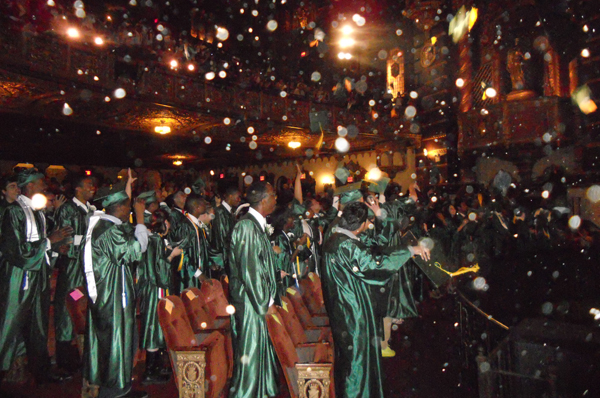
Photo by: Helen Zelon
At their commencement ceremony in June, graduates at McKee Career and Technical High School toss their caps into the air. Principal Sharon Henry quoted a Japanese proverb, in saying that McKee grads “fall down seven times, get up eight.”
No aspect of city government directly affects more people for more years than the public school system, which begins in pre-kindergarten and ends in 12 years or, for some students, a little longer, and which serves a million students at time in 1,800 schools spread across 32 districts. Carmen Farina, Mayor-elect Bill de Blasio’s pick to be schools chancellor, would face an enormous job running that system even if education weren’t so vitally important, so politically weighty and so fraught with controversy.
City Limits devoted a lot of coverage over the past decade to the previous three chancellors (Joel Klein, Cathy Black and Dennis Walcott) and investigated different aspects of the system, from teacher evaluations to the school food system. It’s handy reading for anyone—whether a concerned citizen or the next leader of the nation’s largest school system—who wants to understand the schools a little deeper:
It’s well known that wealthy kids outperform poor kids in school, but now the rich are also pulling away from middle-class students. Why? And is class or race the key factor in how NYC school kids perform?
The DOE is planting seeds for charters to expand in city schools even after Mayor Bloomberg leaves office. But some of the new resources will only be open to those who won charter lotteries in the early grades.
DOE statistics indicate arts instruction is absent from many middle and high schools. But for some principals, arts aren’t an extra—they’re a priority.
Over the 2012-2013 academic year, City Limits followed a few members of the class of 2013 to see how that group of young people navigated the final hurdles of their public school careers, and to look back with them on how Mayor Bloomberg’s reform agenda appeared from a student’s desk.
In the ’60s it was an ambitious experiment in progressive education. Today John Dewey High graduates its final class after being closed as a failing high school. What led the Gravesend facility from success to shut-down?
Originally launched to offer more choice to low-income parents in poorly served neighborhoods, charter schools are increasingly targeting more affluent students in areas that have lots of school options.
The impact of Mayor Bloomberg’s education reforms is being felt well beyond New York as former DOE aides have taken top jobs in other cities and states.
Many private firms’ projects in city schools have not been “disasters.” But that doesn’t mean these multimillion-dollar projects are the best way for a school system to spend its money.
The elementary school and the middle school shared a building without strife. But when one school felt compelled to grow, tensions arose around race, class and space.
In an attempt to sort out all the questions about Bloomberg’s impact on the schools, we decided to revert to a medium that many of us associate with our own time as students—the filmstrip.








